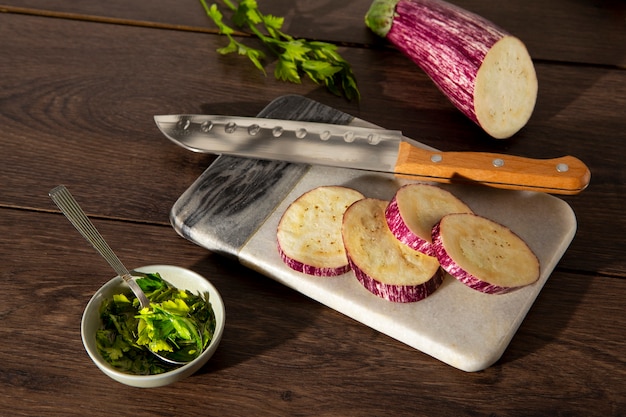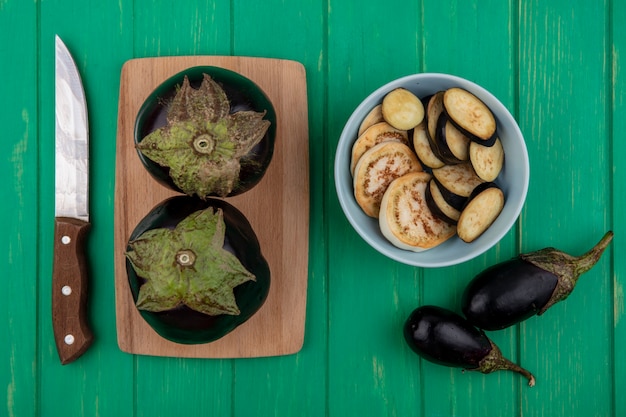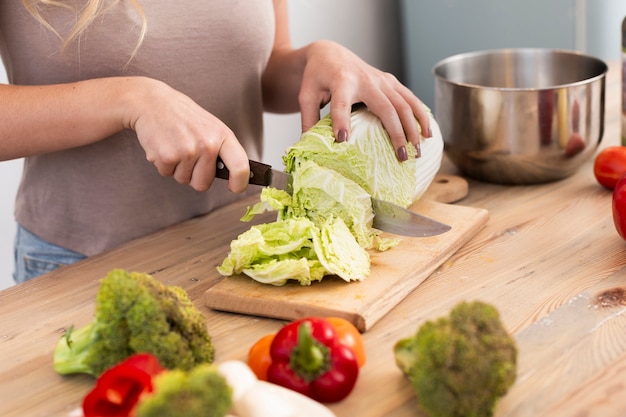I've always held a fondness for artichokes. There's something about their unique texture and flavour that just draws me in. But for years, I avoided cooking them myself. I'd always assumed they were too complicated and time-consuming. Then, one day, I decided to take the plunge and try. To my surprise, it was a revelation! cooking artichokes is actually quite simple, and the results are absolutely delicious.
So, I'm here to share my newfound love for artichokes with you, and to show you how easy it is to prepare them at home. We'll cover everything from selecting the perfect artichoke to cleaning, cooking, and serving them. By the end, you'll be a pro at artichoke cooking, and you'll be able to impress your friends and family with your culinary skills.
(Part 1) Choosing the Right Artichokes: A Guide to Freshness

The first step to delicious artichokes is choosing the right ones. A good artichoke should be firm and heavy for its size, with tightly closed leaves. The colour should be a vibrant green, and the tips should be closed and not wilted.
Inspecting for Quality: What to Look For
When selecting artichokes, I always keep a few key things in mind:
- Firmness: Gently squeeze the artichoke. It should feel firm, not mushy or soft. If it gives way easily, it's probably past its prime.
- Weight: A good artichoke will be heavy for its size. This indicates that it's full of water and flavour.
- Closed Leaves: The leaves should be tightly closed and not open or wilted. This means the artichoke is fresh and hasn't started to dry out.
- Colour: Choose artichokes that are a vibrant green. Avoid any that are dull or brown, as this could indicate they're not fresh.
- Tips: The tips of the leaves should be closed and not open or wilted. This is another sign of freshness.
Avoiding Damaged Artichokes: Recognizing Signs of Spoilage
It's equally important to avoid artichokes that show signs of damage. Here's what to watch out for:
- Bruises: Avoid artichokes with bruises or dark spots on the leaves. These indicate that the artichoke has been mishandled or damaged.
- Soft Spots: Check for soft spots on the base of the artichoke. This could mean the artichoke has started to rot.
- Wilted Leaves: If the leaves are wilted or drooping, the artichoke is not fresh. Choose one with firm and upright leaves.
(Part 2) Preparing Artichokes for Cooking: A Step-by-Step Guide

Now that you've chosen the perfect artichokes, it's time to get them ready for cooking.
Cleaning the Artichokes: Removing the Outer Layers
Cleaning artichokes might seem daunting, but it's actually quite simple. All you need is a sharp knife, a bowl of water, and a bit of patience. Here's how I do it:
- Trim the Stem: Cut off the tough bottom stem of the artichoke using a sharp knife. Leave about an inch of the stem intact.
- Remove the Outer Leaves: Trim away the tough outer leaves until you reach the tender inner leaves. You can discard the outer leaves, or use them to make a delicious broth.
- Cut the Top: Cut off the top of the artichoke, including the pointy tips of the leaves. This will help the artichoke cook evenly.
- Remove the Choke: The choke is the fuzzy, inedible part at the heart of the artichoke. Use a spoon to scrape it out.
- Rinse Thoroughly: Rinse the artichoke thoroughly under cold water to remove any dirt or debris.
Preserving the Artichokes: Keeping Them Fresh for Later
If you're not cooking the artichokes right away, you can preserve their freshness for a few days. Here's how:
- Lemon Juice: Dip the cut surfaces of the artichokes in lemon juice. This will help prevent them from browning.
- Refrigeration: Store the prepared artichokes in an airtight container in the refrigerator for up to 3 days.
(Part 3) Cooking Artichokes: Exploring Different Methods

There are many different ways to cook artichokes, each resulting in a unique texture and flavour. Here are a few of my favourites:
Steaming: A Classic and Simple Technique
Steaming is the most traditional way to cook artichokes, and it brings out their natural flavour. It's a very simple method that requires minimal effort. Here's how I do it:
- Prep the Steamer: Fill a large pot with about an inch of water and bring it to a boil. Place a steamer basket inside the pot.
- Steam the Artichokes: Place the artichokes in the steamer basket, making sure they are not touching. Cover the pot and steam for 30-45 minutes, or until the leaves are tender when pierced with a fork.
- Serve Hot: Serve the steamed artichokes immediately. You can drizzle them with olive oil, lemon juice, and salt and pepper to taste.
Boiling: A Quick and Easy Option
Boiling is another quick and easy way to cook artichokes. It's a good option if you're short on time, and it results in a slightly softer artichoke. Here's how I do it:
- Boil Water: Fill a large pot with water and bring it to a boil. Add a pinch of salt.
- Boil the Artichokes: Carefully place the artichokes in the boiling water. Cover the pot and simmer for 20-30 minutes, or until the leaves are tender when pierced with a fork.
- Serve Hot: Serve the boiled artichokes immediately. You can drizzle them with olive oil, lemon juice, and salt and pepper to taste.
Grilling: A Smoky and Flavourful Delight
Grilling artichokes adds a smoky, charred flavour that elevates their taste. It's a great option for outdoor cooking or for adding a touch of char to your meal. Here's how I do it:
- Prepare the Grill: Preheat your grill to medium heat. Lightly oil the grill grates to prevent sticking.
- Grill the Artichokes: Place the artichokes on the grill and cook for 15-20 minutes, turning them every few minutes to ensure even cooking. The leaves should be slightly charred and tender.
- Serve Hot: Serve the grilled artichokes immediately. You can drizzle them with olive oil, lemon juice, and salt and pepper to taste. You can also add a dollop of pesto or a sprinkle of parmesan cheese.
Roasting: A Simple and Versatile Technique
Roasting artichokes is a versatile method that yields tender and flavourful results. It's a great way to prepare artichokes for a side dish or to add them to a salad. Here's how I do it:
- Prep the Artichokes: Cut the artichokes in half lengthwise and remove the choke. Drizzle them with olive oil and season with salt and pepper.
- Roast the Artichokes: Place the artichoke halves cut-side down on a baking sheet. Roast in a preheated oven at 400°F (200°C) for 30-40 minutes, or until the leaves are tender and slightly browned.
- Serve Hot or Cold: Serve the roasted artichokes hot or cold. You can drizzle them with lemon juice, olive oil, and herbs for added flavour.
(Part 4) Mastering the Art of artichoke dips and Sauces: Transforming a Vegetable into a Culinary Star
Artichokes are incredibly versatile and can be incorporated into a variety of dips and sauces. These are perfect for dipping into, spreading on bread, or adding to your favourite dishes.
Classic Artichoke Dip: A Crowd-Pleaser
Artichoke dip is a timeless favourite, and for good reason. It's creamy, cheesy, and incredibly delicious. Here's my recipe:
- Gather the Ingredients: You'll need cooked artichoke hearts, cream cheese, mayonnaise, Parmesan cheese, garlic, and your favourite spices.
- Combine the Ingredients: In a bowl, combine the cooked artichoke hearts, cream cheese, mayonnaise, Parmesan cheese, garlic, and spices. Mix well until all ingredients are evenly combined.
- Bake or Broil: Transfer the mixture to a baking dish and bake in a preheated oven at 350°F (175°C) for 20-25 minutes, or until bubbly and golden brown. You can also broil the dip for a few minutes to get a nice crispy top.
- Serve Hot: Serve the hot artichoke dip with your favourite chips, crackers, or bread.
Creamy artichoke and spinach dip: A Healthy and Delicious Option
This dip is a healthy twist on classic artichoke dip, packed with spinach and bursting with flavour. It's also a great way to sneak in some extra vegetables.
- Gather the Ingredients: You'll need cooked artichoke hearts, cream cheese, Greek yogurt, spinach, garlic, lemon juice, and your favourite spices.
- Combine the Ingredients: In a food processor, combine the cooked artichoke hearts, cream cheese, Greek yogurt, spinach, garlic, lemon juice, and spices. Pulse until smooth and creamy.
- Serve Cold or Warm: Serve the dip cold or warm with your favourite chips, crackers, or vegetables.
Artichoke and Parmesan Sauce: A Delightful Topping
This sauce is perfect for topping pasta, pizza, or grilled chicken. It's creamy, cheesy, and bursting with artichoke flavour.
- Gather the Ingredients: You'll need cooked artichoke hearts, butter, flour, milk, Parmesan cheese, garlic, and your favourite spices.
- Make the Sauce: Melt the butter in a saucepan over medium heat. Whisk in the flour and cook for 1 minute. Gradually whisk in the milk until the sauce is smooth and thickened. Add the cooked artichoke hearts, Parmesan cheese, garlic, and spices. Simmer for 5 minutes, stirring occasionally.
- Serve Hot: Serve the sauce hot over your favourite dishes.
(Part 5) The Wonderful World of Artichoke Dishes: Recipes and Inspiration
Artichokes are incredibly versatile and can be used in a variety of dishes, from simple salads to elaborate main courses. Here are some ideas for how to incorporate artichokes into your cooking:
Artichokes in Salads: Adding Texture and Flavour
Artichokes are a great addition to salads, providing texture and a delightful flavour. Here are some ideas:
- Grilled artichoke salad: Combine grilled artichoke hearts with fresh greens, cherry tomatoes, red onion, and a lemon vinaigrette.
- Caesar Salad with Artichokes: Add cooked artichoke hearts to a classic Caesar salad for a twist on the traditional recipe.
- Mediterranean Artichoke Salad: Combine artichoke hearts with feta cheese, olives, cucumbers, red onion, and a lemon-oregano vinaigrette.
Artichokes in pasta dishes: A Delicious and Hearty Option
Artichokes add a unique flavour and texture to pasta dishes, creating a hearty and satisfying meal. Here are some ideas:
- Artichoke and shrimp pasta: Toss cooked artichoke hearts with shrimp, garlic, olive oil, and your favourite pasta for a flavourful and easy meal.
- Creamy Artichoke and Mushroom Pasta: Combine cooked artichoke hearts with sautéed mushrooms, cream, Parmesan cheese, and your favourite pasta for a rich and satisfying dish.
- Lemon-Garlic artichoke pasta: Toss cooked artichoke hearts with lemon juice, garlic, olive oil, and your favourite pasta for a light and refreshing meal.
Artichokes in Pizza: A Topped with Unique Flavours
Artichokes can be used as a topping for pizza, adding a unique and delicious flavour. Here are some ideas:
- Artichoke and Spinach Pizza: Top your pizza with cooked artichoke hearts, spinach, garlic, and mozzarella cheese for a flavourful and healthy pizza.
- Artichoke and Goat Cheese Pizza: Combine cooked artichoke hearts with goat cheese, red onion, and a sprinkle of rosemary for a unique and delicious pizza.
- Artichoke and Prosciutto Pizza: Top your pizza with cooked artichoke hearts, prosciutto, mozzarella cheese, and a drizzle of olive oil for a flavourful and satisfying pizza.
(Part 6) Tips and Tricks for Cooking Perfect Artichokes: Mastering the Art of Tenderness and Flavour
With a little bit of practice, you'll be a master at cooking artichokes. Here are some tips and tricks to help you achieve perfect results:
Tenderness: The Key to a Delicious Artichoke
The key to cooking perfect artichokes is to ensure they are tender but not overcooked. Here's how to check for tenderness:
- Fork Test: Insert a fork into the thickest part of an artichoke leaf. If it slides in easily, the artichoke is done. If you meet resistance, cook it for a few more minutes.
- Leaf Flexibility: Gently bend a leaf. If it bends easily without breaking, the artichoke is tender. If it snaps, it needs to cook a little longer.
Preventing Discolouration: Keeping Artichokes Fresh
Artichokes can turn brown quickly when exposed to air. Here's how to prevent discolouration:
- Lemon Juice: Dip the cut surfaces of the artichokes in lemon juice. This will help prevent them from browning.
- Water Immersion: Place the artichokes in a bowl of cold water until you're ready to cook them. This will help keep them fresh.
- Quick Cooking: Once you've prepared the artichokes, cook them as quickly as possible to prevent browning.
Seasoning: Enhancing the Natural Flavour
Artichokes have a mild, nutty flavour that pairs well with a variety of seasonings. Here are some ideas:
- Lemon and Garlic: A classic combination that enhances the artichoke's natural flavour.
- Herbs: Try fresh parsley, dill, basil, oregano, or rosemary for a flavourful touch.
- Cheese: Parmesan, mozzarella, or goat cheese add a creamy and cheesy flavour.
- Spice: Add a pinch of red pepper flakes or cayenne pepper for a touch of heat.
(Part 7) Exploring the Health Benefits of Artichokes: A Nutrient-Packed Vegetable
Besides their delicious flavour, artichokes are also packed with health benefits. They are a good source of vitamins, minerals, and antioxidants. Here are some of the key benefits:
Digestive Health
Artichokes are a good source of fibre, which promotes healthy digestion. They also contain a compound called cynarin, which has been shown to improve liver function and reduce inflammation. Cynarin has even been studied for its potential to aid in weight management and improve cholesterol levels.
Heart Health
Artichokes are rich in antioxidants, which can help protect against heart disease. They also contain potassium, which helps regulate blood pressure. The fibre content in artichokes can also help lower cholesterol levels, further contributing to heart health.
Weight Management
Artichokes are low in calories and high in fibre, which can help you feel full and satisfied, making them a good choice for weight management. The high fibre content helps slow down digestion, making you feel fuller for longer and reducing the urge to snack.
Immune System Support
Artichokes contain vitamin C, which is an important antioxidant that supports a healthy immune system. They also contain zinc, which plays a role in immune function. Vitamin C and zinc are essential for the proper functioning of the immune system, helping the body fight off infections and maintain overall health.
(Part 8) Frequently Asked Questions (FAQs): Solving Common Artichoke Mysteries
Here are answers to some of the most common questions about artichokes:
1. How long do artichokes last in the refrigerator?
Prepared artichokes can last in the refrigerator for up to 3 days, stored in an airtight container. To prevent them from browning, dip the cut surfaces in lemon juice before storing. You can also wrap them in paper towels to absorb any excess moisture.
2. Can I freeze artichokes?
Yes, you can freeze artichokes. To freeze artichokes, blanch them in boiling water for 3-5 minutes, then cool them in ice water. Drain the artichokes and pat them dry. Place them in freezer-safe bags and freeze for up to 3 months.
3. What is the best way to cook artichoke hearts?
Artichoke hearts can be cooked in a variety of ways, including steaming, boiling, grilling, or roasting. Steaming is the most common method, and it brings out the artichoke's natural flavour.
4. Can I eat the whole artichoke?
You can eat most of the artichoke, but not the fuzzy choke in the center. The leaves, heart, and stem are all edible. The leaves are best eaten after they have been cooked, as they become tender and flavorful. The heart is often considered the most delicious part, with a tender and nutty flavour.
5. Are artichokes a good source of protein?
Artichokes are not a significant source of protein. However, they are a good source of fibre, vitamins, minerals, and antioxidants, making them a valuable addition to a healthy diet.
I hope this guide has inspired you to embrace the wonderful world of artichokes. With a little bit of practice, you'll be a master at cooking and enjoying these delicious and healthy vegetables. Happy artichoke cooking!
Everyone is watching

Corn on the Cob: The Ultimate Guide to Perfectly Cooked Ears
Healthy MealsAh, corn on the cob. Just the name evokes images of sunny days, barbecues, and that sweet, juicy flavour that ...

Perfect Pork Roast Oven Cooking Time: A Guide to Delicious Results
Healthy MealsThere's something truly satisfying about a perfectly roasted pork. The aroma alone is enough to make your mout...

Ham Cooking Time: How Long to Bake, Smoke, or Boil a Delicious Ham
Healthy MealsAh, ham. It's a classic, isn't it? A real crowd-pleaser, especially around holidays. And when done right, it'...

Scallops: The Ultimate Guide to Perfect Cooking
Healthy MealsAh, scallops. Those delicate, sweet, and utterly delicious morsels of the sea. They hold a special place in my...

Spaghetti Squash: The Ultimate Guide to Cooking and Serving
Healthy MealsRemember that time you saw spaghetti squash at the supermarket, looking all bumpy and strange, and thought, "W...
